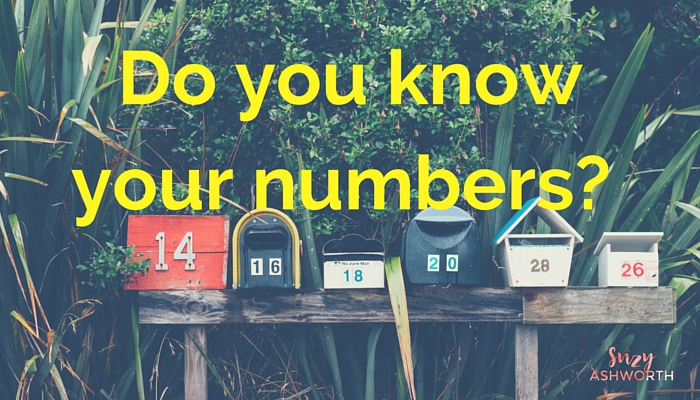Do you know your numbers?

Today I want to talk about failure and what we do. Whether the things that we’re doing that we perceived are failures are really failures.
Have you really failed?,
From a mindset perspective, I know that you know I don’t really believe in failure, that everything is a learning curve and if you’re able to break things down, analyze them, you cannot fail because then you apply the lessons to the next thing you do, and the next time you do things more successfully.
The only time we fail is if we quit or if we continue to make the same mistakes without taking responsibility for our own actions in us not getting the results that we want.
That’s the only time I would say that somebody has failed, but what I have noticed recently, particularly with people who are looking to diversify and are experimenting in an unknown field (although, this can be applied right across the board) is that they had an idea, which is a good idea, and then they put it out there a little bit. They do a couple of blogs. They do a couple of vlogs, and nobody buys, and so they then make the decision that people aren’t really interested in their program.
I want to really emphasize that probably, if you have validated your idea and asked your target audience whether your program and principle is something that they would be interested in and they’ve come back to you and said, “Yes,” it is highly unlikely that people aren’t interested in your program.
What is much more likely is that you have massively underestimated how many people you need to be connecting with on a daily basis, in order to speak to enough people to get a sale.
The only caveat to speaking to enough people is to already have a reasonable size tried within your network who already know your work, already like your work, and already trust your work.
When you have a really deep connection with your audience, if you have an audience already, that’s the only time that the numbers I’m about to quote you mean nothing because you can get a much higher conversion rate from people who know that they can trust you, than from cold traffic, so people that are just coming into your … You’re just getting on their radar.
The average conversion rate for any kind of direct marketing is 1 to 2%. That means that when it comes to creating a new e-mail program, for example, you need to have 100 people on your list to sell one slot.
My question to you is:
How many people are on your e-mail list?
How many people, new people are you connecting with on a daily basis?
How many new people are you attracting to your Facebook page when you’re putting your vlog and blog up there?
How many new people are you speaking to, your attracting into your group, before you tell me that nobody wants your program?
From an advertising perspective, whilst Facebook ads is incredibly cost effective and you hear amazing case studies with people saying, “Yeah, well I paid 50 cents or I paid 10 for your lead.
A really good, general rule of thumb is to think about spending 2 pound for every lead that you get onto your e-mail list, and for those of you in the Baby Business School, I’ve gotten ace Facebook ads bonus, which talks about how we should be using Facebook ads more effectively, so this will make even more sense to you guys. If we’re spending 2 pound a lead, you need to be prepared to spend 200 pounds to get 100 people on your list to sell one space.
I just want you to break it down like that, and then have a look at your launch. Have a look at what the activities that you have done to promote your new service, to promote your new program, and let me know whether you have been hitting those target numbers for that one sale. Now when you introduce things like webinars and things like that into your launch strategy or your marketing strategy, again, when you’re speaking to people, and you’re hoping to demonstrate your expertise, which is why we do these vlogs and blogs, et cetera, your able to build up that “know that I can trust” factor, and you will convert higher than 1 to 2%.
However, you still have to take into consideration how you get people to whom your webinar. I would use Facebook ads. Other people just post organically in different groups, but you still need to get the numbers. What I’m saying to you is, if you have tried something recently and it hasn’t worked, please don’t be disheartened.
Please don’t make the decision that it’s just no good. Really have a look at the practical elements by the numbers, and let me know or at least acknowledge to yourself whether you had enough people seeing your message to start with in order for you to determine whether really was a success or failure or not and then take things from there. That is it for me today. I hope that this was useful and I will see you next time. Okay, bye.



Great timing for me on this topic Suzy, thanks!
I’ve been putting feelers out there to my followers about some new services and booking in some research interviews. I have a small (but very engaged) list and a few people have shown their interest and booked in. The numbers are small but actually after seeing this post, the numbers are actually fairly big in relation to the size of my list so I feel super positive now! 🙂 x